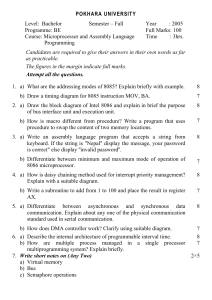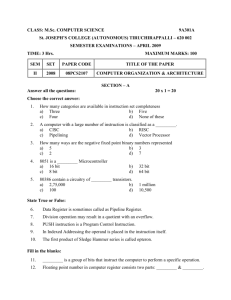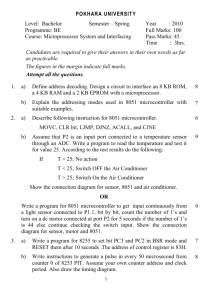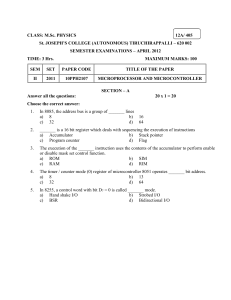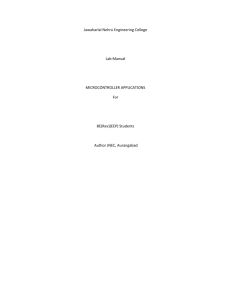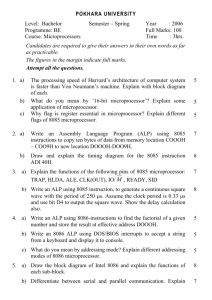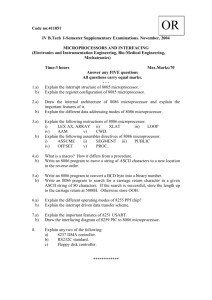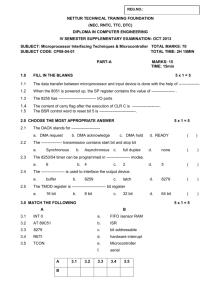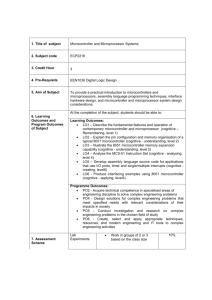Vi Institute of Technology Department of Computer Science
advertisement
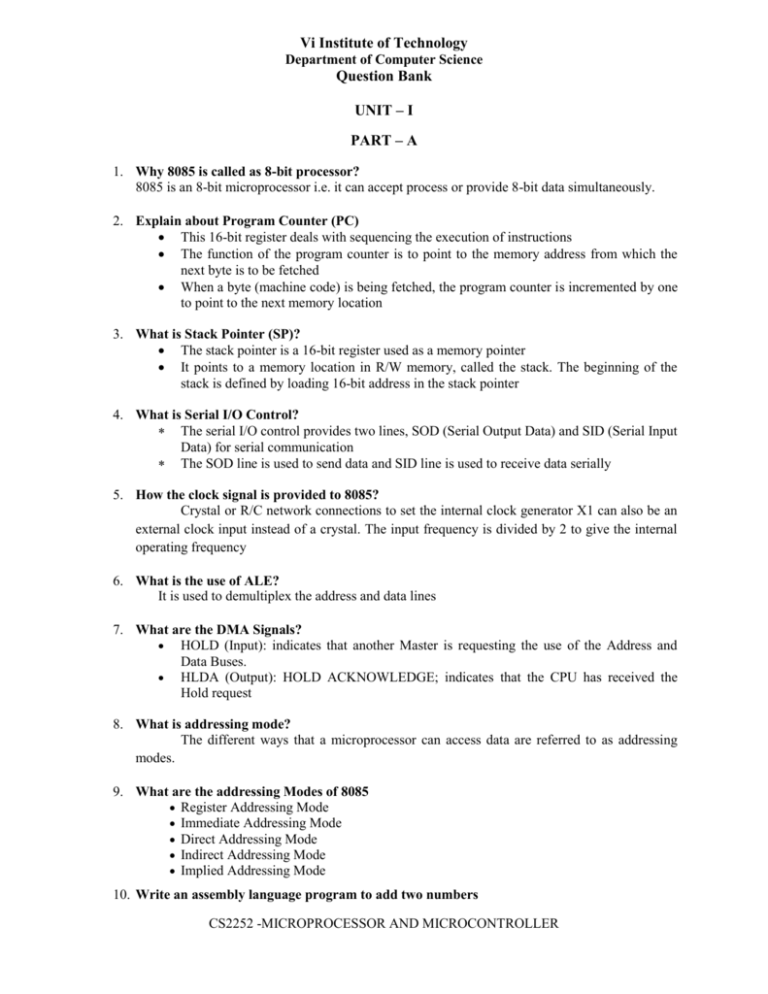
Vi Institute of Technology Department of Computer Science Question Bank UNIT – I PART – A 1. Why 8085 is called as 8-bit processor? 8085 is an 8-bit microprocessor i.e. it can accept process or provide 8-bit data simultaneously. 2. Explain about Program Counter (PC) This 16-bit register deals with sequencing the execution of instructions The function of the program counter is to point to the memory address from which the next byte is to be fetched When a byte (machine code) is being fetched, the program counter is incremented by one to point to the next memory location 3. What is Stack Pointer (SP)? The stack pointer is a 16-bit register used as a memory pointer It points to a memory location in R/W memory, called the stack. The beginning of the stack is defined by loading 16-bit address in the stack pointer 4. What is Serial I/O Control? The serial I/O control provides two lines, SOD (Serial Output Data) and SID (Serial Input Data) for serial communication The SOD line is used to send data and SID line is used to receive data serially 5. How the clock signal is provided to 8085? Crystal or R/C network connections to set the internal clock generator X1 can also be an external clock input instead of a crystal. The input frequency is divided by 2 to give the internal operating frequency 6. What is the use of ALE? It is used to demultiplex the address and data lines 7. What are the DMA Signals? HOLD (Input): indicates that another Master is requesting the use of the Address and Data Buses. HLDA (Output): HOLD ACKNOWLEDGE; indicates that the CPU has received the Hold request 8. What is addressing mode? The different ways that a microprocessor can access data are referred to as addressing modes. 9. What are the addressing Modes of 8085 Register Addressing Mode Immediate Addressing Mode Direct Addressing Mode Indirect Addressing Mode Implied Addressing Mode 10. Write an assembly language program to add two numbers CS2252 -MICROPROCESSOR AND MICROCONTROLLER Vi Institute of Technology Department of Computer Science Question Bank MVI MVI ADD STA HLT A, 20H B, 40H B 2200H ; Load 20H in A ; Load 40H in B ; Add two numbers & save result in A ; Store the result in 2200H memory location : Stop the program execution 11. Write an ALP to store 8- bit data in memory Program 1: MVI STA HLT A, 52H 2000H Program 2: LXI MVI HLT H, 2000H M, 52H 12. Check results after execution of INR B, INR C, INX B instructions Statement: If the contents of B=FFH and C=FFH then after execution of following instructions give the contents of register B and register C INR B B FFH 01H 00H B B=00H and C=FFH INR C C FFH 01H 00H C C=00H and B=FFH INX B BC FFFFH 0001H 0000H BC B=00H and C=00H 13. Write an 8085 assembly language program, which checks to see if the number is even or odd and if it is odd returns a ‘0’ in B register else returns a ‘1’ MVI A, 04H ANI 01 JZ NEXT MVI B, 00H JMP LAST NEXT: MVI B, 01H LAST: HLT 14. What is a flag? Give a note on the use of auxiliary carry flag. 15. State the role of RESETIN and RESETOUT signals in 8085 processor. CS2252 -MICROPROCESSOR AND MICROCONTROLLER Vi Institute of Technology Department of Computer Science Question Bank 16. 17. 18. 19. 20. 21. 22. 23. What is the effect of executing the instruction DAD B and ADD m? Draw the content of the flag register of 8085. How many memory locations can be addressed by 8085 microprocessor? Give an example for direct and indirect addressing modes of 8085. What is the function of priority flag? How 16-bit address is converted into 20-bit address in 8086? Why are the program counter and stack pointer are 16-bit register? What operation can be performed by using the instruction XRA A? Specify the status of Z and CY flag? 24. Name the machine cycles ne4eded to execute the 8025 instruction MVI B, 4FH. 25. Identify the addressing modes of the following 8085 instruction. a). SHLD 2500H b). DCR E. PART – B 1. 2. 3. 4. 5. 6. 7. 8. 9. 10. 11. 12. 13. 14. 15. 16. With neat block diagram, explain the architecture of 8086 microprocessor.(16) Write an 8086 alp to sort out any given 10 numbers in ascending and descending order.(10) Explain the addressing modes of 8085 with an example.(6) Explain the execution of the instruction MVI A,32h with timing diagram.(8) Write an 8085Assembly language program to multiply two 8-bit number, which is stored in the memory location 4500h and 4501h. Store the product in the subsequent memory location?(8) Explain the different addressing modes in 8085 microprocessor. Give two example for each addressing mode.(8) Write an 8085 assembly language program to find the largest 8-bit number among the five numbers which are storied the memory location 4200h to 4204h.(8) Give two example for data transfer instructions, arithmetic instructions, logical instructions and branch instructions of 8085 microprocessor.(8) Draw the functional block diagram of 8085 microprocessor and explain .(8) Write a program to find average of ten numbers. (8) Write a program to divide two eight bit numbers. (8) Explain the classification of 8085 instruction based on its functions. (8) Write a ALP to find the largest number in the given series of 10 data using 8085. (8) Explain the classification of 8085 instructions based on its word length. (8) Write an ALP to move a block of data from location 5000H to 8000H using 8085. (8) Write an 8085 ALP to find the largest number in a array of 10 data. Starting address of the aray of data is 4250H.(8) UNIT – II CS2252 -MICROPROCESSOR AND MICROCONTROLLER Vi Institute of Technology Department of Computer Science Question Bank PART – A 1. How many memory locations can be accessed by 8086 processor? No. of address lines = 20 Memory locations = 2no.of address lines = 220 = 1Mb 2. What are the functions of Bus Interface Unit? ▪ It sends address of the memory or I/O ▪ It fetches instruction from memory ▪ It reads data from port/ memory ▪ It writes data into port/ memory ▪ It supports instruction queuing 3. What is pipelining? The process of fetching the next instruction when current instruction is in execution is called as pipelining 4. If IP= 9F20H and CS=4000H, then find the 20- bit physical address Shift CS one position left, CS= 40000H IP= 9F20H 49F20H 5. Draw the structure of flag register of 8086 6. What are the addressing modes of 8086 processor? Addressing modes for accessing immediate and register data. Addressing modes for accessing data in memory. Addressing modes for accessing I/O ports. Relative addressing mode. Implied addressing mode. 7. Which addressing mode is used to specify branching instruction? Relative addressing mode 8. What is pseudo- operation? There are some instructions in the assembly language program which are not a part of processor instruction set. These instructions are instructions to the assembler, linker and loader. These are referred to as pseudo- operations or as assembler directives. 9. What is procedure? CS2252 -MICROPROCESSOR AND MICROCONTROLLER Vi Institute of Technology Department of Computer Science Question Bank Procedure is a group of instructions stored as a separate program in the memory and it is called from the main program whenever required. The type of procedure depends on where the procedure is stored in the memory. Near Procedure: If the procedure is in the same code segment where the main program is stored then it is called near procedure Far Procedure: If the procedure is in the different code segment then it is called far procedure 10. State the advantage of macro over procedure Macro is a group of instructions. Macro sequences execute faster than procedures because there is no CALL and RET instruction to execute. 11. What is interrupt? When a microprocessor is interrupted, it stops executing its current program and calls a special routine which services the interrupt. The event that causes the interruption is called interrupt 12. What is breakpoint? Breakpoint function is used as a debugging aid. When a breakpoint is inserted the system executes the instructions up to the breakpoint, and then goes to breakpoint procedure (means write a program to display the contents of register, memory location) 13. 14. 15. 16. 17. 18. 19. 20. 21. 22. 23. List out the pin details other than address pins and data pins. What are Assembler directives? Give an example. What is BIOS function call in 8086 microprocessor? What are the difference between 8085 and 8086 processor? Give the operation of CBW and TEST instructions of 8086? Why do we use macros? What address in the interrupt vector table, are used for a Type-2 interrupt in 8086? What are the general purpose register in 8086? Give the importance of the assembler directive EVEN? Name the hardware interrupt of 8086. What is the function of LOCK and RQ/GT signals? PART – B 1. Draw the internal architecture of 8086 microprocessor and explain its BUS Interface Unit (BIU). (8) 2. Give an example for the 8086 instructions: AAA, CWD, JNBE, LAHF, MOVS, RCL, ROL and SAHF. (8) 3. What are the uses of the following assembler directives: DD, ENDS, EVEN and EXTRN. 4. Explain the 8086 Interrupt types with examples. (8) 5. Explain maximum and minimum mode of operation of 8086. (16) 6. Design an 8086 based system in minimum mode containing 64kb of EPROM and 64kb of RAM. (8) 7. Give the functions of NMI, BHE and TEST pins of 8086?(8) 8. Explain how to pas parameters to macros? (8) 9. Explain the interrupt structure of an 8086 microprocessor with 8086 interrupt-pointer table. (8) 10. Write an 8086 assembly language program to read in 100 samples of data at 1-ms intervals. (8) 11. Draw and explain typical minimum mode 8086 systems.(8) CS2252 -MICROPROCESSOR AND MICROCONTROLLER Vi Institute of Technology Department of Computer Science Question Bank 12. Explain about the following assembler directives: END P, EQU, EVEN, EXTRN with examples. (8) 13. What are assembler directives and pseudo ops? (8) 14. Explain 8 addressing modes of 8086 processor with example.(8) 15. Compare macro and procedure. 16. What is BIOS? Discuss the various BIOS function calls.(8) 17. Write an 8086 ALP to find the sum of numbers in the array of 12 lements.(8) UNIT – III PART – A 1. What is multiprocessor? If a microprocessor system contains two or more components that can execute instructions independently, then the system is called multiprocessor system 2. What are the advantages of multiprocessor? Improves cost/ performance ratio of the system If failure occurs, it is easy to find and replace malfunctioning processor No need of centralized system 3. What is closely coupled system? In closely coupled system (CCS) the processors or supporting processors share clock generator, bus control logic, entire memory and I/O subsystem 4. What are the three interconnection networks of CCS? ) Processor- memory interconnection network (PMIN) a) Input- Output processor interconnection network (IOPIN) b) Interrupt- signal interconnection network (ISIN) 5. What is loosely coupled system? In loosely coupled systems, each processor has a separate input- output devices and a local memory. This system also called as distributed system. 6. What are the three interconnection networks of LCS? Simple time shared bus Shared memory system 7. State the advantages of loosely coupled system Better system throughput by having more than one processor Greater degree of parallel processing can be achieved System structure is more flexible A failure in one module does not cause a breakdown of the entire system 8. What is numeric processor? CS2252 -MICROPROCESSOR AND MICROCONTROLLER Vi Institute of Technology Department of Computer Science Question Bank The numeric processor 8087 is a coprocessor which is specially designed to work under the control of the processor 8086 and to support additional numeric processing capabilities. 9. What are the data types of 8087 processor? Word Integer Short Integer Long Integer Packed BCD Short Real Long Real Temporary Real 10. What is normalization? The process of moving the decimal point to the right of the most significant, non zero digit is referred to as normalization 11. Explain mask compare operation The mask compare operation is executed as follows Step 1: Operand byte is logically XORed with lower byte of MC MC = 5578 Operand byte = 38H Masked pattern = 55H 0010 1000 Operand byte 0111 1000 Lower byte of MC 0100 0000 = 40H Step 2: The result of first operation is logically ANDed with higher byte of MC 0100 0000 Result of first step 0101 0101 Higher byte of MC 0100 0000 = 40H 12. What is the use of task pointer of 8089? Stores the address of next instruction to be executed 13. 14. 15. 16. 17. 18. 19. 20. 21. 22. How does co-processor identify the instructions meant for it? Name the signals used by the processor to communicate with an I/O processor. How does CPU differentiate the 8087 instructions from its own instructions? How 8089 operates in loosely coupled configuration and tightly coupled configuration? List any four 8087 data formats. Compare closely and loosely coupled features. What is co-processor? What is floating point co-processor? In what ways are the standards microprocessor and co-processor differ from each other? How does the main processor distinguish its instructions from those for the 8087 as it fetches instructions from memory? 23. What do you mean by CCW in an I/O processor? PART – B 1. Explain salient feature of 8087 co-processor units in architectural diagram. (16) CS2252 -MICROPROCESSOR AND MICROCONTROLLER Vi Institute of Technology Department of Computer Science Question Bank 2. 3. 4. 5. 6. 7. 8. 9. 10. 11. 12. 13. 14. Draw the architecture of 8089 I/O processor and explain its functionalities. (16) Discuss the operation of 8087 numeric data processor. (16) Discuss the architecture of 8089. Discuss the 8087 internal architecture and explain. (8) Give two examples of 8087 data transfer instructions, arithmetic instructions, processor control instructions and transcendental instructions. (8) Draw the architecture of 8089 I/O processor and explain. (8) Explain how I/O processor communicates between the CPU and I/O peripherals with an example(8) Explain the architecture of 8087 numeric data processor? (16) Differentiate closely and loosely couples configurations (6) How is the communication between CPU and IOP being done? (8) Draw the internal block diagram of 8087 co-processor and explain(8) Discuss briefly the data types supported by 8087 Numeric data processor. (8) Discuss the scheme used to solve the bus arbitration problem in multiprocessor. (8) UNIT – IV PART – A 1. Calculate the number of registers in the memory, if memory having 12 address lines and 8 data lines Number of register/ memory = 2Number of address lines = 212 = 4096 2. What are the address decoding techniques? Absolute decoding/ Full decoding Linear Decoding/ Partial decoding 3. Calculate the number of address lines if the size of the memory is 8Kbytes 2Number of address lines = Size of memory = 8Kbytes = 8 × 1024 = 23 × 210 2Number of address lines = 213 Number of address lines = 13 4. What is input port? Input port is used to read data from the input device such as keyboard D0- D7 Data Bus InputPort Keyboard (Tri- state buffer) 5. What is output port? Enable Enable Output port is used to send data to the output device from microprocessor CS2252 -MICROPROCESSOR AND MICROCONTROLLER Vi Institute of Technology Department of Computer Science Question Bank D0 – D7 Data Bus OutputPort Output Device (Latch) Clock CLK 6. What are the operating modes of 8255? a. Bit Set/ Reset (BSR) mode b. I/O mode Mode 0: Simple Input/ Output Mode 1: Input/ Output with handshake Mode 2: Bi- directional I/O data transfer 7. What is handshaking signal? Handshaking signals are used to transfer data between devices whose data transfer speeds are not same For eg, computer can send data to the printer with large speed but printer can’t accept data and print data with this rate. So computer has to send data with the speed with which printer can accept The handshaking signals are used to tell computer whether printer is ready to accept the data or not 8. Write a program to initialize 8255 in the configuration given below: a) Port A: Simple input b) Port B: Simple output c) Port CL: Output d) Port CU: Input Assume address of the control word register of 8255 as 83H Solution 0 0 1 1 0 0 0 Control Word 1 = 98H Source Program MVI A, 98H OUT 83H 9. Write a program to initialize 8255 in the configuration given below: a) Port A: Output with handshake b) Port B: Input with handshake c) Port CL: Output d) Port CU: Input Assume address of the control word register of 8255 as 23H Solution 0 1 0 1 1 1 0 Control Word 1 CS2252 -MICROPROCESSOR AND MICROCONTROLLER = AEH Vi Institute of Technology Department of Computer Science Question Bank Source Program MVI A, AEH OUT 23H 10. Difference between 8253/ 8254 Sl. No 1 2 3 Intel 8253 Operating frequency 0- 2.6MHz Uses NMOS technology Read- Back command not available Intel 8254 Operating frequency 0- 10MHz Uses HMOS technology Read- Back command available 11. What is Counter Latch Command? First, control word is written into the control register Second, two I/O read operations are performed by CPU a. The first I/O operation reads the low order byte b. The second I/O operation reads high order byte 12. What are the operating modes of 8253? i) Mode 0 (Interrupt on terminal count) ii) Mode 1(Hardware Retriggerable one- shot) iii) Mode 2(Rate Generator) iv) Mode 3 (Square wave Rate Generator) v) Mode 4(Software triggered Strobe) vi) Mode 5(Hardware triggered Strobe) 13. What is the use Priority Encoder block of DMAC? If DMA channels requesting service simultaneously, it provides the priority for each channel 14. Explain the features of 8259 (Interrupt Controller)? It can manage eight priority interrupts By cascading nine 8259s it is possible to get 64 priority interrupts The 8259A can be programmed to accept either level activated or edge activated interrupt request With the help of 8259A user can get the information of pending interrupts, in-service interrupts and masked interrupts 15. What is the use of data bus buffer of 8259? This buffer is used to interface the internal data bus of 8259 to the system data bus 16. Define the three modes of data transmission Simplex Half duplex Full duplex 17. If the memory chip size is 1024×2 bits, how many chips are required to make 4K bytes of memory 4Kbytes = 4×1024 bits CS2252 -MICROPROCESSOR AND MICROCONTROLLER Vi Institute of Technology Department of Computer Science Question Bank No of memory chips = (4 × 1024)/ (1024 ×2) = 2 chips 18. List the operating modes of 8255 a) Bit Set/ Reset (BSR) mode b) I/O mode Mode 0: Simple Input/ Output Mode 1: Input/ Output with handshake Mode 2: Bi- directional I/O data transfer 19. What is meant by I/O mapped I/O interfacing? In I/O mapped I/O, the 8085 uses IO/M signal to distinguish between I/O read/ write and memory read/write operations For I/O data transfer the 8085 has two o IN instruction o OUT instruction The IN instruction inputs data from an input device into the accumulator to an output device The OUT instruction sends the content of the accumulator to an output device These are two byte instruction. The second byte of the instruction specifies the address of an I/O device When we want to interface an I/O device, it is necessary to assign a device address or a port number 20. Define baud rate Number of bits per second 21. 22. 23. 24. 25. 26. 27. 28. 29. State the use of cascading signals of 8259 programmable interrupt controller? Name the sensors used in a microprocessor. What are the modes of operation in 8237? What is the requirement to be met while interfacing memory or I/O devices to 8085 processor? List the six modes of timer. Why a latch is used for an O/P port, but a tri-state buffer can be used for an input port? What is bus stealing? What are the operating modes of 8255? What are the port lines of programmable port devices automatically put in the input mode when the device is first powered- up or reset? 30. How to change the direction of the stepper motor from clockwise direction to anticlockwise direction using a program segment. 31. What is DMA? 32. How many address lines and data lines necessary for ascending 32kx8 memory? PART – B 1. 2. 3. 4. 5. 6. Explain in detail about the 8257 DMA controller with a neat block diagram. (16) Explain in detail about interfacing a temperature controller with a microprocessor. (16) Explain the (i) modes of operation of timer and (ii) operation of interrupt controller. (16) Discuss briefly about keyboard/display controller. (16) Explain the operating modes of 8255 programmable peripheral interface. (8) Draw the control word format of 8254 programmable interval timer and explain. (8) CS2252 -MICROPROCESSOR AND MICROCONTROLLER Vi Institute of Technology Department of Computer Science Question Bank 7. Draw the architectural block diagram of 8259 programmable interrupt controller and explain. (8) 8. Write a program to make the stepper motor to rotate both clockwise and counter clock wise direction. (8) 9. Bring about the features of 8251. (6) 10. Discuss how 8251 is used for serial data communication. (6) 11. Explain the advantages of using the USART chips in microprocessor based systems. (4) 12. Explain the operating modes of 8253 timer. (8) 13. What is DMA? Explain the DMA based data transfer using 8237 DMA controller. (8) 14. Explain parallel communication interface with microprocessor.(8) UNIT – V PART – A 1. What are the functions of port 3? RD WR T1 T0 INT1 INT0 TXD RXD - P3.7 - P3.6 - P3.5 - P3.4 - P3.3 - P3.2 - P3.1 - P3.0 - Read Data - Write Data - Timer/ Counter 1 external input - Timer/ Counter 0 external input - Interrupt 1 input pin - Interrupt 2 input pin - Transmit data pin - Receive data pin 2. What is the function of Address Latch Enable (ALE)? To demultiplex address and data lines (AD0 – AD7) 3. What is Stack Pointer (SP)? It is an 8- bit register Stack is the area of internal RAM. It is used to store internal RAM address 4. What is Data Pointer (DPTR)? It is a 16- bit register It is used to store 16- bit address It consists of two 8- bit registers; DPH, DPL 5. What is Program Counter (PC)? It is a 16- bit register It is used to store the address of next instruction to be executed It is automatically incremented to point the next instruction 6. Draw the structure of TMOD register Gate C/T M1 M0 Gate C/T M1 M0 7. State the mode in which timer will be operated after execution of following instructions Timer 0 AND MICROCONTROLLER -MICROPROCESSOR Timer CS2252 1 Vi Institute of Technology Department of Computer Science Question Bank a. MOV TMOD, #01H b. MOV TMOD, #12H Solution a. TMOD= 0000 0001; mode1 of timer0 b. TMOD= 0001 0010; mode2 of timer0, mode1 of timer1 8. Determine the timer’s clock frequency and its period for 8051 systems with following crystal frequencies a. 12 MHz b. 11.0592 MHz Solution a. 12 MHz ÷ 12 = 1MHz Time period = 1/ f = 1/ 1MHZ = 1µs b. 11.0592 ÷ 12 = 921.6 KHz Time period = 1/ f = 1/ 921.6 KHz = 1.085µs 9. Difference between timer and counter a. Timer If C/T bit in the TMOD register is 0, timer mode is selected Timer clock frequency = System frequency/12 b. Counter If C/T bit is 1, counter mode is selected Counter gets its pulses from outside the 8051. The pin T0(P3.4) and T1(P3.5) of 8051 are used for applying pulses counter0 and countre1 respectively 10. What are two types of liquid crystal displays according to the theory of operation Dynamic scattering Field effect 11. Difference between microprocessor and microcontroller Microprocessor Microprocessor contains ALU control unit different register And interrupt circuit It has one or two bit handling instruction It has more data transfer instructions Microcontroller Microprocessor contains MP memory ,i/o Interfacing circuit and peripheral devices such as A/D converter serial I/O timer It has many bit handling instruction It has one or two data transfer instructions 12. Name the flags that are stored in PSW in 8031 CS2252 -MICROPROCESSOR AND MICROCONTROLLER Vi Institute of Technology Department of Computer Science Question Bank CY- Carry flag AC- Auxiliary Carry F0- User defined flag OV- Overflow flag P- Parity flag 13. What is stack and stack pointer? Stack is the area of internal RAM. Stack pointer is an 8- bit register. It is used to store internal RAM address 14. What are the on chip hardware resources available in 8051 microcontroller? Memory I/O interfacing circuit Peripheral devices such as A/D converter serial I/O timer 15. What is the function of register bank? 32 working registers are organized into 4 banks Only one register bank can be used at a time Each bank has 8-registers (R0 – R7) and each can store 8-bit data 16. 17. 18. 19. 20. 21. 22. 23. 24. 25. 26. 27. What are the advantages of using a microcontroller in place of a microprocessor? Mention any two applications that use ADC and DAC. What is Baud rate for mode 0 operation of the serial port of 8051? In the program status word of 8051, the bits RS0 and RS1 are 1 and 0, then which register bank is selected for operations? What are the difference between a microprocessor and a microcontroller? How is the selection of particular register bank done in 8051? What is the use of Vrefpin in the ADC? What is the need for de-bouncing the keyboard? What is the difference between MOVX and MOV? What is the difference between watch dog timer and ordinary timer? List the features of the parallel ports of 8051 microcontroller. What is the size of the on-chip program memory and on-chip data memory of 8051 microcontroller. PART – B 1. Explain the features of 8051 microcontroller and compare it with 8086 microprocessor. 2. Write short notes on register set of 8051 microcontroller. 3. Explain with a help of a neat block diagram how DAC is interfaced with 8051 micro controller.(16) 4. Describe the functions of the signals present in 8051. (8) 5. How a DAC is interfaced with 8051?(8) 6. Explain how an LCD and keyboard is interfaced with 8051. (12) 7. Describe about serial port interface of 8051. (4) 8. Draw the architecture block diagram of 8051 microcontroller and explain. (8) 9. Draw the circuit with interface an LCD with microcontroller and explain how to display the data using LCD. (8) 10. Draw the circuit diagram to interface a keyboard with microcontroller and explain how microcontroller recognizes the key-press. (8) CS2252 -MICROPROCESSOR AND MICROCONTROLLER Vi Institute of Technology Department of Computer Science Question Bank 11. Program the on-chip timer in 8051 to be an event counter. Use model and display the binary count on, P1. Set the initial; count to be zero. (8) 12. Describe the 8051 I/O port structure. (6) 13. Explain the internal and external data memory organization of 8051. (10) 14. How do you interface micro controller with an ADC? Explain. (8) 15. What is timer/ counter. Explain the 16-bit timer mode and 8-bit auto-reload mode of 8051 microcontroller. (8) 16. How to transfer data between a PC and microcontroller using serial communication? Draw the necessary diagrams and explain. (8) 17. Draw the pin diagram of 8051 microcontroller and explain the functions of each pin. (10) 18. Discuss briefly various registers in 8051 microcontroller. (6) 19. Explain interfacing of 4 x 4 matrix keyboard to the 8051 microcontroller with neat diagram. (10) 20. Briefly write about the IE and IP register in 8051 microcontroller. (6) CS2252 -MICROPROCESSOR AND MICROCONTROLLER
